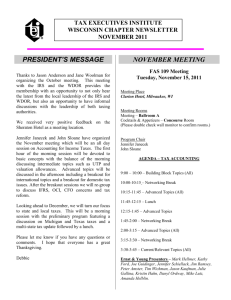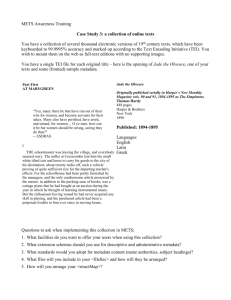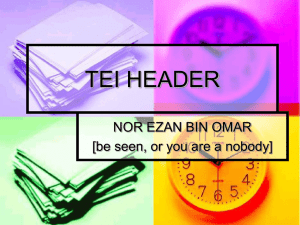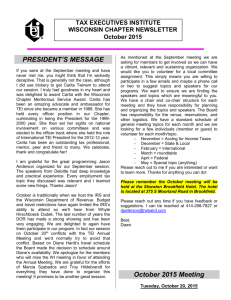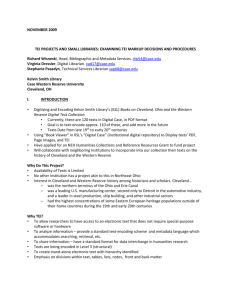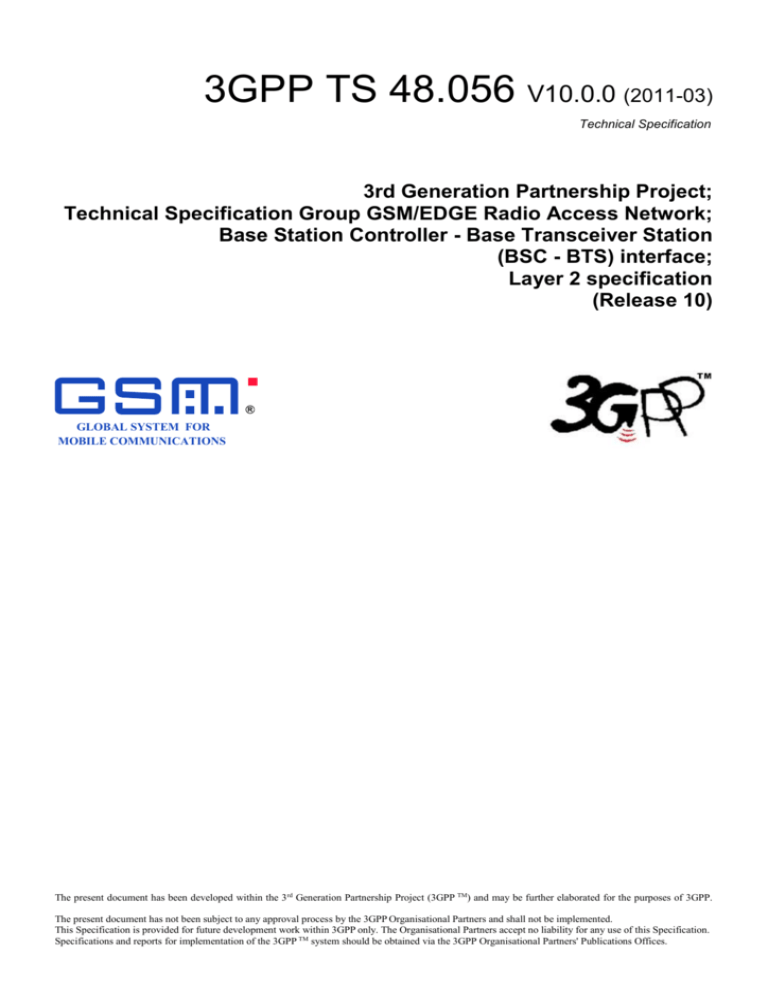
3GPP TS 48.056 V10.0.0 (2011-03)
Technical Specification
3rd Generation Partnership Project;
Technical Specification Group GSM/EDGE Radio Access Network;
Base Station Controller - Base Transceiver Station
(BSC - BTS) interface;
Layer 2 specification
(Release 10)
R
GLOBAL SYSTEM FOR
MOBILE COMMUNICATIONS
The present document has been developed within the 3 rd Generation Partnership Project (3GPP TM) and may be further elaborated for the purposes of 3GPP.
The present document has not been subject to any approval process by the 3GPP Organisational Partners and shall not be implemented.
This Specification is provided for future development work within 3GPP only. The Organisational Partners accept no liability for any use of this Specification.
Specifications and reports for implementation of the 3GPP TM system should be obtained via the 3GPP Organisational Partners' Publications Offices.
Keywords
GSM, radio
3GPP
Postal address
3GPP support office address
650 Route des Lucioles - Sophia Antipolis
Valbonne - FRANCE
Tel.: +33 4 92 94 42 00 Fax: +33 4 93 65 47 16
Internet
http://www.3gpp.org
Copyright Notification
No part may be reproduced except as authorized by written permission.
The copyright and the foregoing restriction extend to reproduction in all media.
© 2010, 3GPP Organizational Partners (ARIB, ATIS, CCSA, ETSI, TTA, TTC).
All rights reserved.
UMTS™ is a Trade Mark of ETSI registered for the benefit of its members
3GPP™ is a Trade Mark of ETSI registered for the benefit of its Members and of the 3GPP Organizational Partners
LTE™ is a Trade Mark of ETSI currently being registered for the benefit of its Members and of the 3GPP Organizational Partners
GSM® and the GSM logo are registered and owned by the GSM Association
Contents
Foreword............................................................................................................................................................. 4
1
Scope ........................................................................................................................................................ 4
2
References ................................................................................................................................................ 4
3
Definitions and abbreviations................................................................................................................... 5
4
General description .................................................................................................................................. 5
5
Functional contents .................................................................................................................................. 6
6
LAPD functions........................................................................................................................................ 6
6.1
Exceptions and modifications .................................................................................................................................. 6
6.1.1
Void ................................................................................................................................................................... 7
6.1.2
Command/Response field bit (C/R) ................................................................................................................... 7
6.1.3
Service Access Point Identifier (SAPI) .............................................................................................................. 7
6.1.4
TEI for point-to-point data link connection ....................................................................................................... 7
6.1.5
Commands and responses .................................................................................................................................. 7
6.1.6
Exchange identification (XID) command/response ........................................................................................... 7
6.1.7
MDL-XID .......................................................................................................................................................... 7
6.1.8
PH-DATA, PH DEACTIVATE and PH-ACTIVATE....................................................................................... 8
6.1.9
MPH-ACTIVATE, MPH-DEACTIVATE an MPH-INFORMATION ............................................................. 8
6.1.10
Priority indicator ................................................................................................................................................ 8
6.1.11
Terminal Endpoint Identifier (TEI) management procedures ............................................................................ 8
6.1.11.1
General ......................................................................................................................................................... 8
6.1.11.2
TEI assignment procedure ............................................................................................................................ 8
6.1.11.3
TEI identity verify procedure ..................................................................................................................... 10
6.1.11.4
Formats and codes. ..................................................................................................................................... 10
6.1.12
Automatic negotiation of data link layer parameters ....................................................................................... 10
6.1.13
Establishment procedures ................................................................................................................................ 10
6.1.14
N(S) sequence error ......................................................................................................................................... 11
6.1.15
List of system parameters ................................................................................................................................ 11
6.1.15.1
Timer T200................................................................................................................................................. 11
6.1.15.2
Maximum number of retransmissions (N200)............................................................................................ 11
6.1.15.3
Maximum number of octets in an information field (N201) ...................................................................... 11
6.1.15.4
Maximum number of transmission of the TEI identity request message (N202) ....................................... 11
6.1.15.5
Maximum number of outstanding frames (K) ............................................................................................ 11
6.1.15.6
Timer T201................................................................................................................................................. 11
6.1.15.7
Timer T202................................................................................................................................................. 12
6.1.15.8
Timer T203................................................................................................................................................. 12
6.1.16
Data link layer monitor function ...................................................................................................................... 12
6.1.17
Miscellaneous .................................................................................................................................................. 12
Annex A (informative):
Change History .............................................................................................. 13
Foreword
This Technical Specification has been produced by the 3 rd Generation Partnership Project (3GPP).
The contents of the present document are subject to continuing work within the TSG and may change following formal
TSG approval. Should the TSG modify the contents of the present document, it will be re-released by the TSG with an
identifying change of release date and an increase in version number as follows:
Version x.y.z
where:
x the first digit:
1 presented to TSG for information;
2 presented to TSG for approval;
3 or greater indicates TSG approved document under change control.
y the second digit is incremented for all changes of substance, i.e. technical enhancements, corrections,
updates, etc.
z the third digit is incremented when editorial only changes have been incorporated in the document.
1
Scope
The present document specifies the link layer used for signalling on the A-bis interface between BSC and BTS. The use
and general aspects of the A-bis interface are described in 3GPP TS 48.051 and the interface aspects in 3GPP TS
48.052.
The Link Access Procedure on the D-channel (LAPD) specification used on the A-bis interface in the GSM PLMN is a
subset of the EN 300 125 which in turn has less options than the CCITT Recommendation Q.921.
This description contains first the protocol definitions and second the services provided by the layer 2 to the layer 3.
2
References
The following documents contain provisions which, through reference in this text, constitute provisions of the present
document.
References are either specific (identified by date of publication, edition number, version number, etc.) or
non-specific.
For a specific reference, subsequent revisions do not apply.
For a non-specific reference, the latest version applies. In the case of a reference to a 3GPP document (including
a GSM document), a non-specific reference implicitly refers to the latest version of that document in the same
Release as the present document.
[1]
3GPP TS 21.905: "Vocabulary for 3GPP Specifications".
[2]
3GPP TS 48.051: "Base Station Controller - Base Transceiver Station (BSC - BTS) interface;
General aspects".
[3]
3GPP TS 48.052: "Base Station Controller - Base Transceiver Station (BSC - BTS) interface;
Interface principles".
[4]
Void.
[5]
Void.
[6]
Void.
[7]
Void.
[8]
Void.
[9]
Void.
[10]
Void.
[11]
Void.
[12]
Void.
[13]
Void.
[14]
Void.
[15]
Void.
[16]
Void.
[17]
Void.
[18]
Void.
[19]
CCITT Recommendation Q.921: "Integrated services digital network (ISDN) user-network
interface - Data link layer specification".
[20]
EN 300 125: "Integrated Services Digital Network (ISDN); User-network interface data link layer
specification Application of CCITT Recommendations Q.920/I.440 and Q.921/I.441".
3
Definitions and abbreviations
Abbreviations used in the present document are listed in 3GPP TS 21.905.
4
General description
The following information categories are supported by the procedures of this layer 2 Recommendation:
-
signalling (including Short Message Service (SMS) information);
-
operation and maintenance;
-
layer 2 management.
For each of these categories the BSC may have one or more layer 2 links to every TRX and BCF.
The signalling links over the A-bis interface are addressed to the different units by Terminal Endpoint Identifiers (TEI).
The same unit will normally have more than one functional entity. The logical links between different functional
entities are identified by functional addresses, the Service Access Points Identifier (SAPI).
Figure 1 shows the architectural model with different layer 2 links.
A number of logical links may be multiplexed on each physical link. The same layer 2 logical link may not be
distributed over more than one physical link.
____________________
| ________
|
| |
|
|
| |
| __
|
__
______
| |
|| |_______RSL________SAPI_=_0___| |__|
|
| |
|| |_______OML________SAPI_=_62__| |__|
|
| |
|| |_______L2ML_______SAPI_=_63__| |__| TRX |TEI 1
| |
|| |
| |__|
|
| |
||__|
|__| |______|
| |LAYER 2|
|
__
______
| |
| __
|
| |__|
|
| |
|| |_____|_RSL________SAPI_=_0___| |__|
|
| |
|| |_______OML________SAPI_=_62__| |__| TRX |TEI 2
| |
|| |_______L2ML_______SAPI_=_63__| |__|
|
| | T E I || |
| | |______|
| |
|| |_______RSL________SAPI_=_0___| |
______
| |
|| |_______OML________SAPI_=_62__| |__|
|
| |
|| |_______L2ML_______SAPI_=_63__| |__|
|
| |
||__|
| |__| TRX |TEI 3
| |
|
|
| |__|
|
| |MANAGE-|
|
|__| |______|
| |MENT
| __
|
__
______
| |
|| |_______OML________SAPI_=_62__| |__|
|
| |
|| |_______L2ML_______SAPI_=_63__| |__| BCF |TEI 4
| |
||__|
|__| |
|
| |
| __
_ |
__
|
|
| |
|| | _ _ | OML _ _ _ _SAPI = 62_ | |__|
|TEI 65
| |
|| | _ _ | L2ML_ _ _ _SAPI = 63_ | |__|
|
| |_______||__|
|
|__| |______|
|
|
|___________________|
Figure 4.1: An example of Logical Layer 2 links supported by three permanent
and one semipermanent links
5
Functional contents
The basic functional content of the layer 2 protocol is:
-
transparent layer 2 links and time fill;
-
point-to-point dedicated layer 2 links addressing both physical entities and functional entities;
-
point-to-multipoint addressed links used for layer 2 management;
-
basic functions for TEI assignment and management;
-
basic priority functions;
-
basic supervision of links when not carrying traffic;
-
sequence control;
-
transmission error control;
-
control of errors not recoverable by retransmission.
6
LAPD functions
The LAPD functions as specified in EN 300 125 are applicable. However, the exceptions and modifications specified in
the remainder of the present document shall be used.
6.1
Exceptions and modifications
In the following headlines from EN 300 125 are kept and references are made to the corresponding clause of EN 300
125.
6.1.1
Void
6.1.2
Command/Response field bit (C/R)
(Refer to EN 300 125, part 2, clause 3.3.2)
In GSM PLMN's BSC represents the network side and TRX/BCF the user side of the interface.
6.1.3
Service Access Point Identifier (SAPI)
(Refer to EN 300 125, part 2, clause 3.3.3)
The SAPI values for the A-bis interface are as listed in table 6.1.3.
Table 6.1.3: Allocation of SAPI values and priority classes
SAPI value
0
1
16
62
63
All others
6.1.4
Related layer 3 or layer management entity
Radio signalling procedures
Reserved for packet mode communications using Q.931 call control procedures
(Not used in GSM PLMN)
Reserved for packet communication conforming to X.25 level 3 procedures (Not
used in GSM PLMN
Operation and maintenance procedure
Layer 2 management procedures
Reserved for future standardization
Priority
2
1
1
-
TEI for point-to-point data link connection
(Refer to EN 300 125, part 2, clause 3.3.4.2).
The remaining Terminal Endpoint Identifier (TEI) values are used for the point-to-point data link connections
associated with the addressed Service Access Point (SAP). The range of TEI values shall be allocated as shown in table
6.1.4.
Table 6.1.4: Allocation of TEI values
TEI value
0-63
64-126
NOTE:
6.1.5
User type
TEI assignment for fixed TRX and BCF addresses
TEI assignment for additional, TRX or BCF addresses
A BCF is given a separate layer 2 link only if it is not integrated with a TRX.
Commands and responses
(Refer to EN 300 125, part 2, clause 3.6.1)
The XID command and response are not used.
6.1.6
Exchange identification (XID) command/response
(Refer to EN 300 125, part 2, clause 3.6.12)
This functionality is not used.
6.1.7
MDL-XID
(Refer to EN 300 125, part 2, clause 4.1.1.9)
This functionality is not used.
6.1.8
PH-DATA, PH DEACTIVATE and PH-ACTIVATE
(Refer to EN 300 125, part 2, clauses 4.1.1.10 - 4.1.1.12)
This functionality is not relevant.
6.1.9
MPH-ACTIVATE, MPH-DEACTIVATE an MPH-INFORMATION
(Refer to EN 300 125, part 2, clauses 4.1.1.13 - 4.1.1.15)
This functionality is not relevant.
6.1.10
Priority indicator
(Refer to EN 300 125, part 2, clause 4.1.3.1)
The different SAPIs are given the priority classes as listed in table 1 when contending (with priority one as the highest).
6.1.11
Terminal Endpoint Identifier (TEI) management procedures
(Refer to EN 300 125, part 2, clause 5.3)
Due to the special assignment functions needed on the A-bis interface there are modifications and additions to the
assignment procedures. The rest of clause 5.3 in EN 300 125, part 2, is kept if not stated otherwise.
6.1.11.1
General
(Refer to EN 300 125, part 2, clause 5.3.1)
TEI management for A-bis interface is based on the following procedural means:
-
a Subset of the TEI assignment procedures;
-
the TEI check procedures;
-
the TEI remove procedures;
-
an additional TEI assignment procedure.
The TEI management needs procedures to check the used TEI values and procedures for reaction in situation where
more than one TRX equipment uses the same TEI value. In addition to the fixed values it shall be possible to use
additional TEI value to the same TRX equipment and thus increase the signalling capacity.
6.1.11.2
TEI assignment procedure
(Refer to EN 300 125, part 2, clause 5.3.2)
The TEI assignment procedure used on the A-bis interface has some additions to the automatic TEI assignment
procedure specified in EN 300 125, part 2.
To facilitate the configuration control in the BSC each TRX will have a fixed TEI and possibly get access to one or
more additional TEIs assigning physical channels/layer 2 links.
The layer 2 links may all be turned on and off according to the normal automatic TEI assignment scheme but the TRX
may only request identified TEI values which is (semi-) permanently programmed or programmed by operation and
maintenance messages.
In GSM the reference number Ri is not used. It is only misoperation situations resulting from double failures that could
be prevented/solved faster by this parameter. The marginal advantage is not supposed to motivate the application of a
random generator and the checking procedure.
The subset of the automatic assignment procedure applicable for the first layer 2 link to a TRX shall have the following
modifications to EN 300 125, part 2:
-
the identity request shall have an Ai value in the range 0-63 identifying the TEI value which is requested for
activation;
-
on reception of the identity request message the BSC will check that the requested TEI may be used from the
configurations aspects and then perform a normal TEI check procedure to prevent a double assignment;
-
if the TEI request is accepted an identity assigned message with the requested TEI number is received by TRX
before the expiry of timer T202;
-
a successful assignment procedure is shown in figure 6.1.11.2.a.
TRX
|
|
|
|
|
|
|
|
|
|
|
|
|
|
|
|
|
|
|
|
|
|
|
V
T202
Identity request (Ai)
Identity check request (Ai)
|
|
Normal
|
identity
|
check
|
procedure
|
No answer
|
Identity assigned (Ai)
BSC
|
|
|
|
|
|
|
|
|
|
|
|
|
|
|
|
| T201
|
|
|
V
If timer T201 expires the request shall be repeated once and timer T201 restarted
Figure 6.1.11.2.a: A successful assignment procedure
If timer T202 expires the assignment procedure did not succeed, and the TRX will take further actions in accordance
with the procedures as specified in EN 300 125, part 2.
If within the assignment procedure an identity check response is received, then the requested TEI value is already in
use. There shall be no answer to the requesting TRX and an error indication shall be sent to O&M.
An example of a non-successful assignment procedure is shown in figure 6.1.11.2.b.
T202
|
|
|
|
|
|
V
TRX
|
|
|
|
|
|
|
|
|
Identity request (Ai)
Identity check request (Ai)
Identity check response (Ai)
BSC
|
|
|
|
|
|
|
|
|
| T201
V
If timer T201 expires the request shall be repeated once and timer T201 restarted
Figure 6.1.11.2.b: An example of assignment in error case (TEI value already in use)
The additional TEI assignment procedure is equivalent to the normal one with two exceptions:
-
the TEI value is in the range: 64-126;
-
the TEI value and the identification of which physical link it shall operate on is transmitted to the TRX from
BSC in an operation and maintenance message. This layer 3 O&M message is transferred on an already assigned
layer 2 link. (See 12-series of GSM Technical Specifications).
The successful additional assignment procedure is shown in figure 6.1.11.2.c.
T202
|
|
|
|
|
|
|
|
|
|
V
TRX
|
|
|
|
|
|
|
|
|
|
|
|
|
|
O&M command (Ai, physical address)
Identity request (Ai)
Identity check request (Ai)
|
|
Identity check
| Procedure
|
with no response from
| the TRX side
|
Identity assigned (Ai)
BSC
|
|
|
|
|
|
|
|
|
|
|
|
|
|
|
|
| T201
|
|
|
V
If timer T201 expires the request shall be repeated once and timer T201 restarted
Figure 6.1.11.2.c: The procedure for assigning an additional TEI to a TRX or BCF
6.1.11.3
TEI identity verify procedure
(Refer to EN 300 125, part 2, clause 5.3.5)
This procedure is not used.
6.1.11.4
Formats and codes.
(Refer to EN 300 125, part 2, clause 5.3.6)
All messages except Identity verify and Identity denied are used. The Ai is used as described in clause 6.1.11.2, the
modification to EN 300 125, part 2, clause 5.3.2. The Ri parameter is not used and will always be coded 0000 0000.
The coding of each field of the various messages is specified in table 6.1.11.4.a.
Table 6.1.11.4.a: Codes for messages concerning TEI management procedures
Message name
Identity request
(user to network)
Identity assigned
(network to user)
Identity check request
(network to user)
Identity check response
(user to network)
Identity remove
(network to user)
6.1.12
Layer
management
entity identifier
0000 1111
0000 1111
0000 1111
0000 1111
0000 1111
Reference
number
Ri
Not used
(code 0)
Not used
(code 0)
Not used
(code 0)
Not used
(code 0)
Not used
(code 0)
Action indicator
Ai
0000 0001
Ai = 0-126
0000 0010
Ai = 0-126
Assigned TEI value
Ai = 0-127
Check all TEI values
Ai = 0-126
TEI value to be checked
Ai = 0-126
TEI value in use
Ai = 0-127
Request for removal of all TEI values
Ai = 0-126
TEI value to be removed
0000 0100
0000 0101
0000 0110
Automatic negotiation of data link layer parameters
(Refer to EN 300 125, part 2, clause 5.4 and annex IV)
The procedures are not supported.
6.1.13
Message
type
Establishment procedures
(Refer to EN 300 125, part 2, clause 5.5.1.2)
The timer T203 shall be implemented in the equipment on both sides of interface A-bis.
6.1.14
N(S) sequence error
(Refer to EN 300 125, part 2, clause 5.8.1 and appendix I)
As it is the case in EN 300 125, the optional procedure for retransmission as described in Appendix I is not supported.
6.1.15
List of system parameters
(Refer to EN 300 125, part 2, clause 5.9)
All the default values are given in the following clauses.
6.1.15.1
Timer T200
(Refer to EN 300 125, part 2, clause 5.9.1)
The default value of timer T200 is 240 ms starting from the end of a transmitted frame.
NOTE:
6.1.15.2
This timer depends on the timer values used for supervising the message flow between the Mobile Station
(MS) and the network. The proper operation of the procedure requires timer T200 to be greater than the
maximum time between transmission of command frames and the reception of their corresponding
response or acknowledgement frames and shorter than the shortest layer 3 timer used for supervising this
message flow.
Maximum number of retransmissions (N200)
(Refer to EN 300 125, part 2, clause 5.9.2)
The default value of (N200) is 3.
6.1.15.3
Maximum number of octets in an information field (N201)
(Refer to EN 300 125, part 2, clause 5.9.3)
The default and maximum value of (N201) is 260 octets for all SAPI values.
6.1.15.4
Maximum number of transmission of the TEI identity request message
(N202)
(Refer to EN 300 125, part 2, clause 5.9.4)
Not used (i.e. equivalent to infinity).
6.1.15.5
Maximum number of outstanding frames (K)
(Refer to EN 300 125, part 2, clause 5.9.5)
For the SAPI value 0 identifying radio signalling the default (K) value shall be 2. For all other SAPIs the value shall be
set to the fixed value of 1.
NOTE:
6.1.15.6
The value of K for SAPI value 0 shall always be greater than the k value for the other SAPIs.
Timer T201
(Refer to EN 300 125, part 2, clause 5.9.6)
Timer T201 shall have the default value 1 second.
6.1.15.7
Timer T202
(Refer to EN 300 125, part 2, clause 5.9.7)
The minimum time between the transmission of TEI Identity request messages is a system parameter (T202) which
shall be set to 15 seconds.
6.1.15.8
Timer T203
(Refer to EN 300 125, part 2, clause 5.9.8)
The timer T203 represents the maximum time allowed without frames being exchanged for each TEI. The value of
timer T203 shall be 10 seconds.
6.1.16
Data link layer monitor function
(Refer to EN 300 125, part 2, clause 5.10)
The supervisory function will be used in the equipment on both sides of the A-bis interface.
6.1.17
Miscellaneous
(Refer to EN 300 125, part 2, appendix I-IV)
The functionalities specified in appendix I-IV of EN 300 125, part 2, is not used.
Annex A (informative):
Change History
TSG #
March 2011
TSG Doc.
CR
Rev
-
-
-
Subject/Comment
Rel-10 version created based on v9.0.0
New
10.0.0


